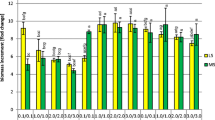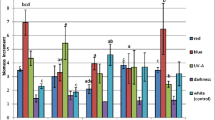Abstract
Apple shoot cultures accumulate phenolic acids, flavonols, catechins, and procyanidins. Increasing the sucrose content and reducing the macronutrient content of culture media both resulted in an enhanced content of phenolic substances. The qualitative composition of the substances was affected as well. Morphology of the shoots, preculture and time of sampling in the subculture interval influenced the reaction pattern.
Similar content being viewed by others
References
Amiot MJ (1990) Les composés phénoliques de la pomme. Intérêts agronomiques et conséquences technologiques. 9o Colloque sur les recherches fruitères (pp. 279–289). Avignon
Barnes EH& Williams EB (1961) The role of phloridzin in the hostparasite of apple scab disease. Can. J. Microbiol. 7: 525–534
Bauer H, Treutter D, Schmid PPS, Schmitt E& Feucht W (1989) Specific accumulation of o-diphenols in stressed leaves of Prunus avium. Phytochem. 28: 1363–1364
Bauer H& Treutter D (1990) Identification of Pelargonium-cultivars by phenolic ‘fingerprints'. II. Cultivar identification by HPLCanalysis of leaf phenols combined with discriminant analysis. Gartenbauwiss. 55: 187–191
Bongue-Bartelsman M& Philipps DA (1995) Nitrogen stress regulates gene expression of enzymes in the flavonoid biosynthetic pathway of tomato. Plant Physiol. Biochem. 33: 539–546
Bryant JP, Chapin FS, Reichardt PB& Clausen TP (1987) Response of winter chemical defense in Alaska paper birch and green alder to manipulation of plant carbon/nutrient balance. Oecologia 72: 510–514
Del Moral R (1972) On the variability of chlorogenic acid concentration. Oecologia 9: 289–300
DiCosmo F& Towers GHN (1983) Stress and secondary metabolism in cultured plant cells. In: Timmermann BN, Steelink C& Loewus FA (eds) Phytochemical Adaptions to Stress (pp. 97–176). Plenum Press, New York
Estiarte M, Filella I, Serra J& Penuelas J (1994) Effects of nutrient and water stress on leaf phenolic content of peppers and susceptibility to generalist herbivore Helicoverpa armigera (Hubner). Oecologia 99: 387–391
Feucht W& Schmid PPS (1988) Flavanols in needles of Abies alba in response to different rural sites. Angew. Botanik 62: 21–30
Gershenzon J (1983) Changes in the levels of plant secondary metabolites under water and nutrient stress. In: Timmermann BN, Steelink C& Loewus FA (eds) Phytochemical Adaptions to Stress (pp. 273–320). Plenum Press, New York
Holowoczak J, Kuc J& Williams EB (1962) Metabolism of D-and L-phenylalanine in Malus related to susceptibility and resistance to Venturia inaequalis. Phytopath. 52: 1019–1023
Kirkham DS (1957) The significance of polyphenolic metabolites of apple and pear in the host relation of Venturia inaequalis and Venturia pirina. J. Gen. Microbiol. 17: 491–504
Koeppe DE, Southwick LM& Bittell JE (1976) The relationship of tissue chlorogenic acid concentrations and leaching of phenolics from sunflowers grown under varying phosphate nutrient conditions. Can. J. Bot. 54: 593–599
Larsson S, Wiren A, Lundgren L& Ericsson T (1986) Effects of light and nutrient stress on leaf phenolic chemistry in Salix dasyclados and susceptibility to Galerucella lineola (Coleoptera). OIKOS 47(2): 205–210
Lewis NG& Yamamoto E (1989) Tannins – their place in plant metabolism. In: Hemingway RW& Karchesy JJ (eds) Chemistry and Significance of Condensed Tannins (pp. 23–46). Plenum Press, New York
Mayr U (1995) Einfluß des Phenolstoffwechsels beim Apfel (Malus domestica) auf das Resistenzpotential gegen Apfelschorf (Venturia inaequalis). Ph.D. Thesis, Technical University of Munich
Mayr U, Fünfgelder S, Treutter D& Feucht W (1995a) Induction of phenol accumulation by pesticides under the control of environmental factors. Proc. European Foundation for Plant Pathology: 399–402
Mayr U, Treutter D, Santos-Buelga C, Bauer H& Feucht W (1995b) Developmental changes in the phenol concentrations of ‘Golden Delicious’ apple fruits and leaves. Phytochem. 38(5): 1151–1155
Mayr U, Michalek S, Treutter D& Feucht W (1997) Phenolic compounds of apple and their relationship to scab resistance. J. Phytopath. 145: 69–75
Michalek S, Mayr U, Treutter D, Lux-Endrich A, Gutmann M, Feucht W& Geibel M (1999) Role of flavan-3-ols in resistance of apple trees to Venturia inaequalis. Acta Hort. 484: 535–539
Mori T& Sakurai M (1994) Production of anthocyanin from strawberry cell suspension cultures; effects of sugar and nitrogen. J. Food Sci. 59(3): 588–593
Murashige T& Skoog F (1962) A revised medium for rapid growth and bioassays with tobacco tissue cultures. Physiol. Plant 15: 473–497
Nozzolillo C (1978) The effects of mineral nutrient deficiencies on the anthocyan pigmentation in vegetative tissues. Phytochem. Bull. 11: 48–54
Oydvin J& Richardson DG (1987) A paper chromatographic survey of the phenol content of apple peel from scab resistant and scab susceptible genotypes. Norwegian J. Agr. Sci. 1: 7–13
Pincinelli A, Dapena E& Mangas JJ (1995) Polyphenolic pattern in apple tree leaves in relation to scab resistance. A preliminary study. J. Agric. Food Chem. 43: 2273–2278
Pritchard S, Peterson C, Runion GB, Prior S& Rogers H (1997) Atmospheric CO2 concentration, N availability, and water status affect patterns of ergastic substance deposition in longleaf pine (Pinus palustris Mill.) foliage. Trees 11(8): 494–503
Raa J (1968) Polyphenols and natural resistance of apple leaves against Venturia inaequalis. Neth. J. Pl. Path. 74: 37–45
Treutter D (1987) Modelluntersuchungen zur Akkumulation des Flavanons Prunin an Prunus-avium-Kalluskulturen. Gartenbauwiss. 52: 196–199
Treutter D (1989) Chemical reaction detection of catechins and proanthocyanidins with 4-dimethylaminocinnamaldehyde. J. Chromatogr. 467: 185–193
Treutter D (2000) Biosynthesis of phenolic compounds and its regulation in apple. Plant Growth Regulation (in press)
Treutter D, Galensa R, Feucht W& Schmid PPS (1985) Flavanone glucosides in callus and phloem of Prunus avium: Identification and stimulation of their synthesis. Physiol. Plant. 65: 95–101
Treutter D& Feucht W (1988) Accumulation of the flavonoid prunin in Prunus avium/P. cerasus grafts and its possible involvement in the process of incompatibility. Acta Hortic. 227: 74–78
Treutter D& Feucht W (1990) The pattern of flavan-3-ols in relation to scab resistance of apple cultivars. J. Hort. Sci. 65: 511–517
Treutter D, Santos-Buelga C, Gutmann M& Kolodziej (1994) Identification of flavan-3-ols and procyanidins by HPLC and chemical reaction detection. J. Chromatogr. A 667: 290–297
Author information
Authors and Affiliations
Corresponding author
Rights and permissions
About this article
Cite this article
Lux-Endrich, A., Treutter, D. & Feucht, W. Influence of nutrients and carbohydrate supply on the phenol composition of apple shoot cultures. Plant Cell, Tissue and Organ Culture 60, 15–21 (2000). https://doi.org/10.1023/A:1006406527242
Issue Date:
DOI: https://doi.org/10.1023/A:1006406527242




